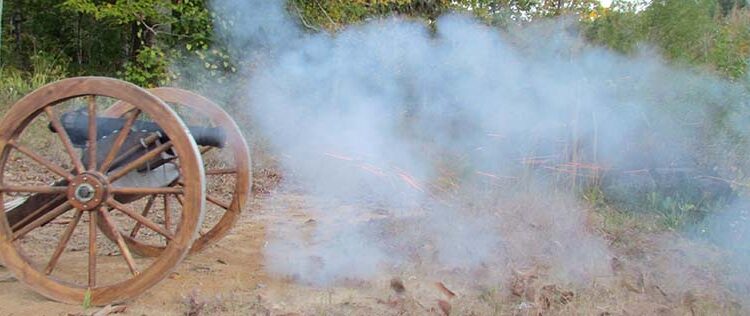By Will Dabbs MD
Photos by Sarah Dabbs
What makes a gun guy a gun guy? Somewhere hidden on the Y-chromosome there must be a tiny bit of DNA that activates a man’s desire to own and shoot firearms. No matter your background or hometown, if you have the gene it is in your nature. There’s simply no fighting it.
I like them all. My particular proclivity is black and scary but I admire a decent pocket pistol as much as the next guy and my heart races at the sight of a classic black powder revolver. If one plastic handgun is good then half a dozen is even better and simply being in the presence of an original WWII-era German machine gun leaves me giddy. Just what is the next step for the committed American gun guy looking to take his collection to the next level? After you have overflowed the gun box with black rifles, tactical handguns, sound suppressors, and maybe even a machine gun or three, it is time to build yourself a cannon.
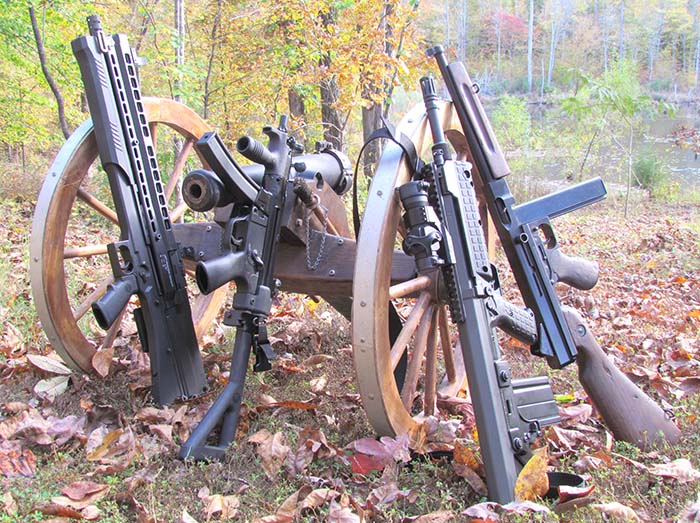
Rules and Regulations
Amazingly, there really aren’t any. If it uses separate ammunition and loads from the front you can build, buy, or own most anything you want without so much as a nod to the federal government. Coehorn mortars, Parrot rifles, and Napoleon howitzers – the world is your playground, go wild. Without all-encompassing government regulation how is it that we are not simply awash in cannon-related crime? Indeed, I suppose some things are simply imponderable.
Interestingly, it does not cost a great deal to get into miniature artillery so long as you are handy in a workshop. The same money that might get you a low-end black rifle would set you up with everything you need to add a truly respectable black powder cannon to your collection. The modest version profiled here cost less than half that.
We selected a 1/3-scale Napoleon howitzer. The originals sported a three-inch bore so ours is an inch exactly. That is the equivalent of a 4-gauge shotgun. This yields a size and footprint small enough to be manhandled readily without a team of horses yet still sports enough boom to put a little hair on your chest.
Now a bit of explanation is in order. This project really is within the capabilities of the average American handyman in possession of a back porch, an electric drill, and a few basic carpentry tools. The components are available at very reasonable cost from the internet and Home Depot and the resulting artillery piece will add a definitive flair to any decent gun collection. If properly executed, the resulting gun and carriage are quite attractive and your spouse may even let you display it as décor in the living room – maybe.
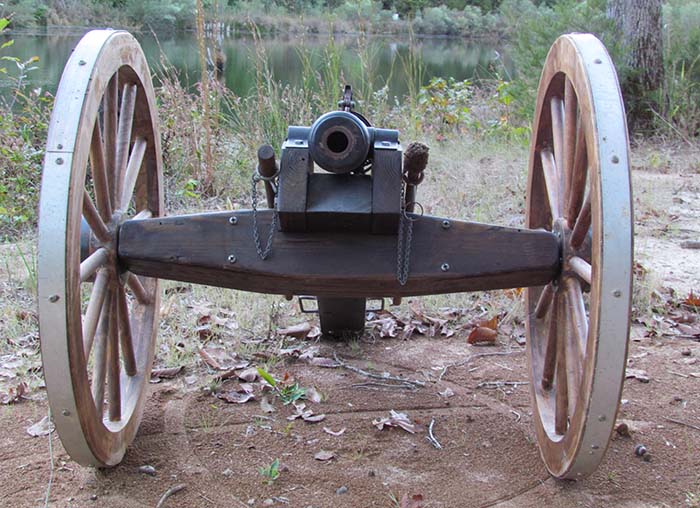
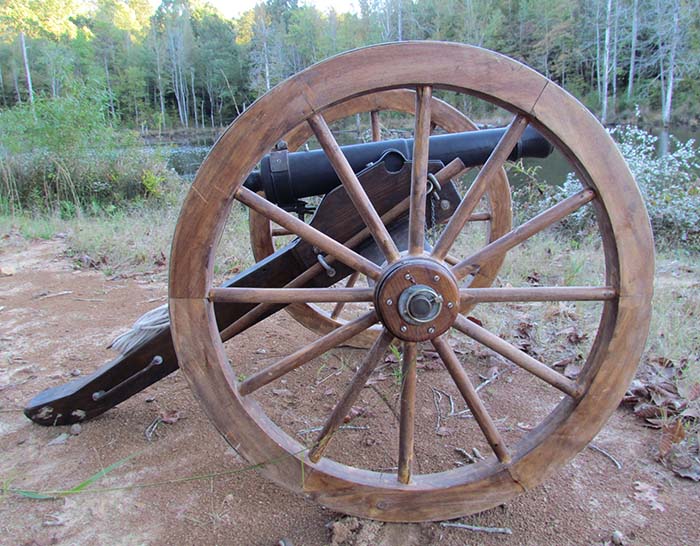
Components
The barrel is the hard part. Everything else you build yourself. A little internet research uncovered a howitzer barrel of the appropriate dimensions. There are sizes and configurations available for any budget ranging from those that launch little musket balls all the way up to the full-scale Civil War-era real steel. The barrel liner in our example is high quality steel nested within a sand-cast iron casing. The fuse hole must be drilled by the user but the barrel is otherwise ready to go out of the box.
Our cannon was a home-school project and it took a day at a local military park to draw and dimension the carriage from the static display versions at the Vicksburg, Mississippi, battlefield. The American South is dotted with these parks but if you do not live near one the internet will provide whatever pictures or schematics you might need. Don’t fret too much about the details. Just make it really stout.
The wagon wheels used on this artillery carriage would be a bit tedious to build from scratch so a pair of decorative wheels from Harbor Freight Tools provided a starting point. These wheels are available online and are dirt cheap. The downside is that they are subsequently fairly flimsy. The wheels are designed as garden decorations and are not intended for hard use. However, after firing this cannon regularly for fifteen years these cheap decorative wheels are still soldiering along. We did form rims for the wheels out of aluminum stock to make them a bit more robust.
The lumber for the carriage itself came from Home Depot. The center piece to the trail began life as a 4×4 fence post. Figure out what you want and design it from scratch. That is half the fun. If the artillery carriage with its wagon wheels and elevation device seem too onerous just build a naval carriage. This design uses the same gun tube but incorporates small solid wooden wheels and can be fabricated by stacking two-by-fours in place. It is little more than a chunky box. If having fun on the range overwhelms your desire for historical accuracy just forget the wheels altogether.
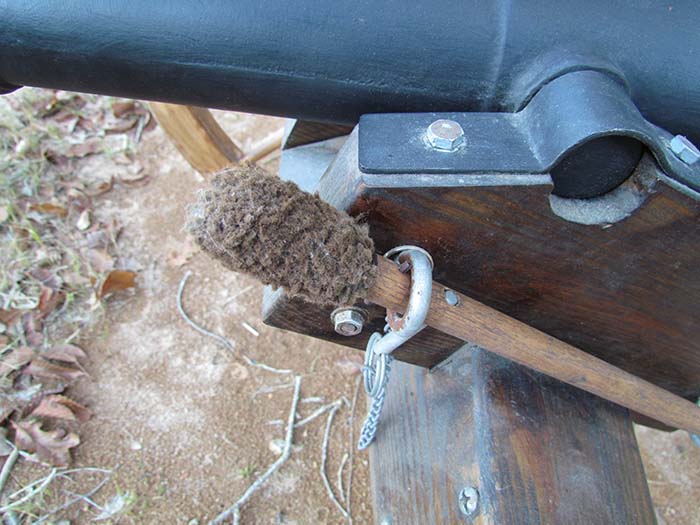

Details
The elevation device began life as a hefty machine screw and a nut secured in the carriage. This is not really necessary, some naval carriages just used a wooden wedge, but it is cool to be able to dial-in your shots. The bore mop is at its heart a cleaning attachment designed for a 10-gauge shotgun mounted on a dowel. A homebuilt ramrod had a similar genesis. Large bore eyebolts mount both attachments on the carriage.
A steel rod serves as an axle and clevis pins allow the wheels to be removed for transportation in an SUV. A little time with a hammer and some small-caliber steel bar stock beats out the rest of the appliqué accessories for the carriage. The internet will provide pictures of the originals.
Drilling the fuse hole is painless with a hand drill just be careful to get it aligned properly. Measure the depth of the bore with a dowel or cleaning rod to set the position of the hole along the tube’s length. If desired the gun can be fired with nothing more than waterproof cannon fuse available in rolls online. For a little extra bit of coolness we designed a lanyard system that uses musket caps.
Thread the hole with a hand tap to accept a standard musket nipple. The tap is maybe three bucks from the local hardware store and anyone can use it. The nipple seats in place and accepts Civil War-era musket caps. An old belt and some scrap steel form a little housing with a manual hammer that pivots on a machine screw. A little work with a Dremel tool produces a groove for the lanyard cord that applies enough mechanical advantage to detonate the cap. It is easier to build than to describe and works swimmingly though the lanyard must be snatched with some vigor to detonate the cap consistently.
There are a few aspects of the design that are critical for safety. The recoil on this gun with a full charge is impressive so the carriage itself needs to be robust. Drill and glue dowels across the grain on all load-bearing portions and use long lag bolts to secure the mounting straps over the trunnions. The mounting straps are built from light gauge steel stock beaten into the right shape with a ball peen hammer.
The finish is at the discretion of the builder. Deep walnut stain makes the carriage look classy and some decent spray paint designed for barbecue grills has kept the tube rust free for more than a decade and a half. Now that the carriage is complete and the priming system in place it is time to retire to the range.
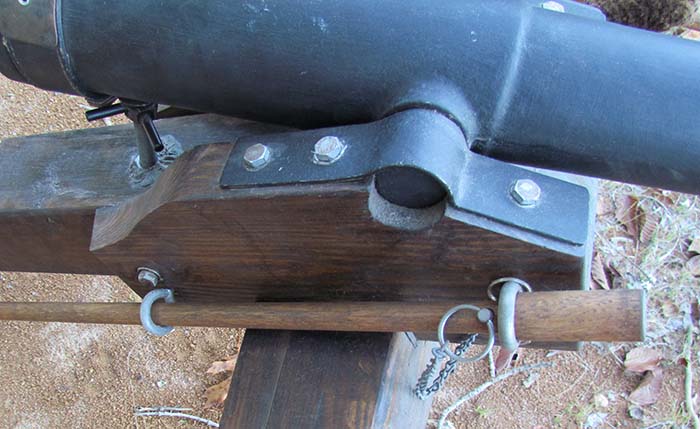
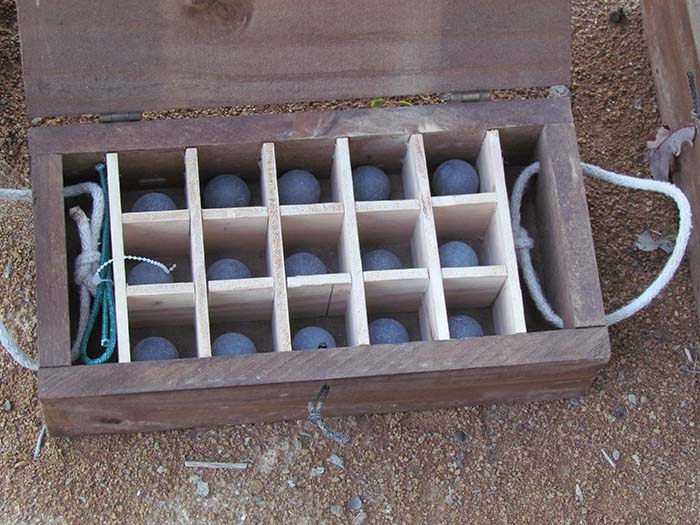
Turning Black Powder into Air Pollution
The barrel manufacturer will provide recommended black powder loads. Never use modern nitrocellulose powders unless you crave a fast and gory death. Black powder is a fairly slow-burning propellant and modern gunpowder would result in unacceptable pressures that can rupture the barrel. Pack your powder charges in paper or foil and secure them with thread or tape in advance. Use a piece of wire to puncture the charge through the flash hole to provide an unimpeded path between the cap and the propellant. Track down or build a couple of simple wooden boxes with rope handles for your ammunition and firing supplies to complete the effect.
As regards projectiles let your imagination run wild. Molds for cannonball fishing sinkers are available online to produce cannonballs of any reasonable size. Your local tire place can either give you tire weights or sell them to you for practically nothing. A cheap hot plate and an old cooking pot will melt the lead. I typically use a propane torch to accelerate the process.
Be forewarned, lead is quite toxic and if you spill molten lead on your foot you will wish you hadn’t. Look around online to find the safest ways to manage your own lead casting and don’t handle the stuff without gloves. Interestingly, a four-ounce lead ball has a one-inch diameter but the sleeve in our cannon barrel had a tiny seam that originally prevented our using true one-inch balls. The most convenient projectiles come from steel bar stock cut into little cylinders with a cutoff wheel on a table saw. They are not particularly accurate but they do make a massive splash downrange. Cardboard tubing filled with concrete works great as well and can be made in volume for pennies.
Dixie cups filled with BBs, fishing sinkers, or musket balls properly loaded over wadding yield splendid service as grapeshot. Old batteries shoot just fine as well if your sense of ecological responsibility allows you to deposit them three feet deep into your backstop. For the most part anything you can stuff down the bore in reasonable quantities makes for effective ammunition. Load the gun with nothing more than newspaper and it still makes an awesome bang.
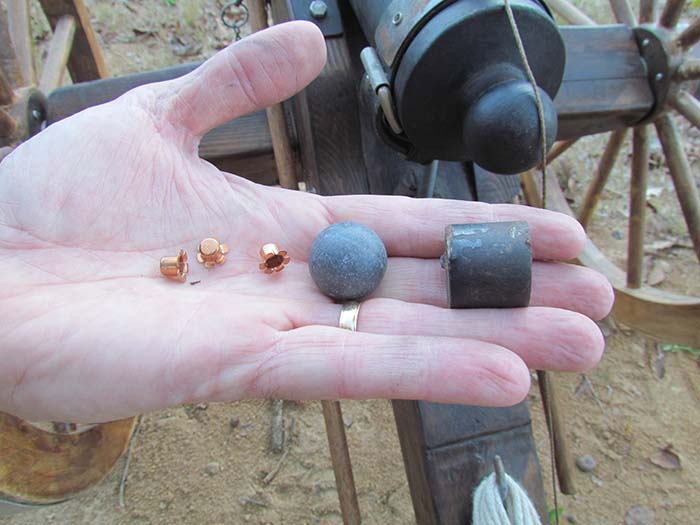
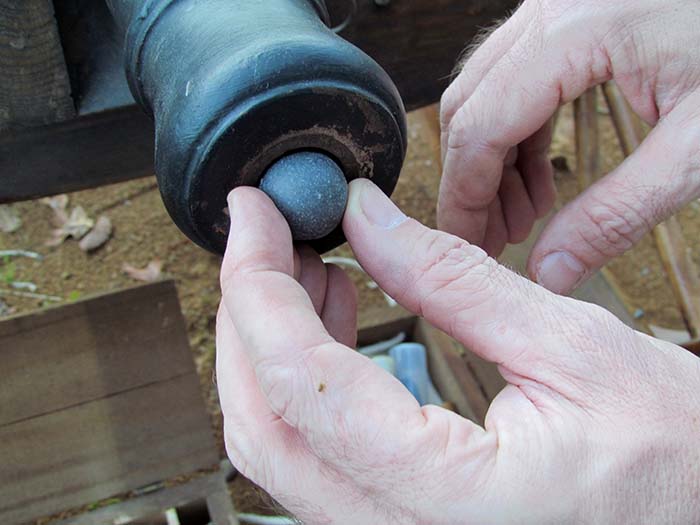
Theatrics
The practical effect of miniaturized cannon fire must be seen to be believed. Even this modest gun is amazingly powerful. Steel bar projectiles sink deep into tree trunks and the crack of firing is audible for miles. Fire the gun at dusk and the fireball is the size of a washing machine. Even in bright sunshine the massive cloud of white smoke and the inimitable smell of burned black powder strike a visceral cord.
As with all pursuits involving firearms, such things are terribly unforgiving of inattention or stupidity. A home built cannon can kill or maim you but so can your high-end black rifle. The same basic gun safety tenets that drive your forays to the range with more conventional iron hold you in good stead with miniaturized artillery. Don’t walk in front of the gun, be completely certain of your back stop, use eye and ear protection, swab the bore between shots with a little water, and check everything several times before firing. Just remember that this gun is incredibly powerful and shoots a really long ways.
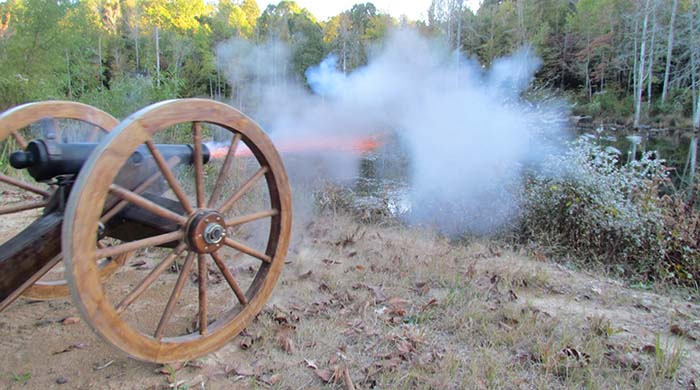
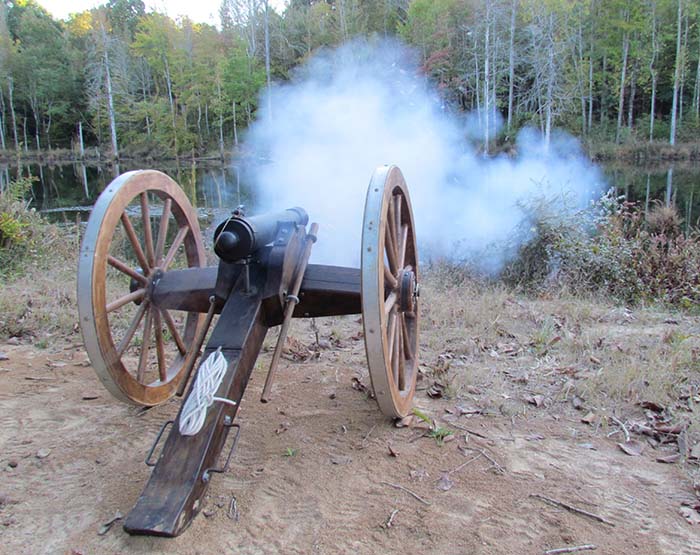
Parting Shots
So, if your collection has expanded to the point that your last trip around the local gun show left you feeling unfulfilled you might want to consider a little DIY artillery. For a surprisingly small investment in materials the typical American gun guy with even a little mechanical aptitude can build up a Napoleon howitzer aesthetically pleasing enough to sit next to the coffee table in your living room. This same gun will launch a quarter pound lead ball through a tree trunk or spray the countryside with a charge of grapeshot. Should your aspirations take you in a different direction you could build a Coehorn mortar that will launch a soft drink can filled with sand into low earth orbit. I think that may be my next project. Stay tuned.
| This article first appeared in Small Arms Review V18N2 (April 2014) |



